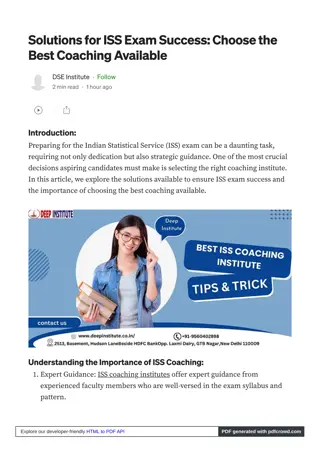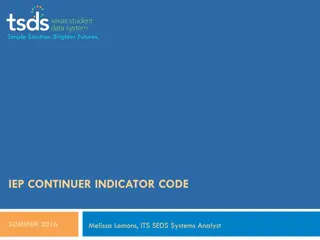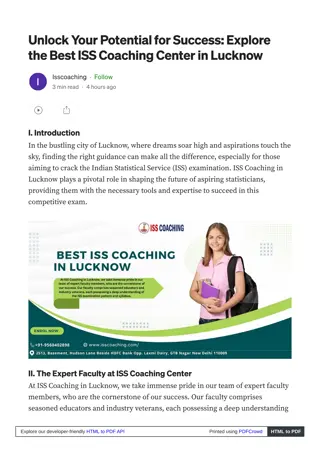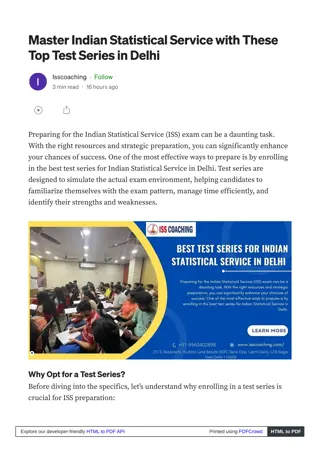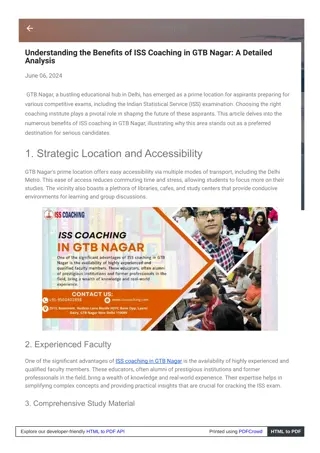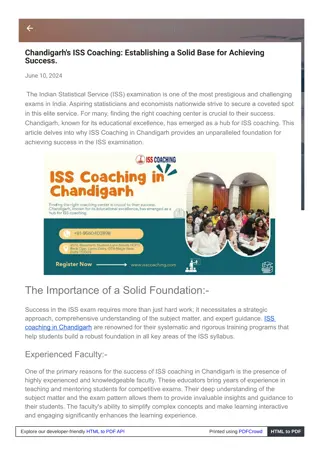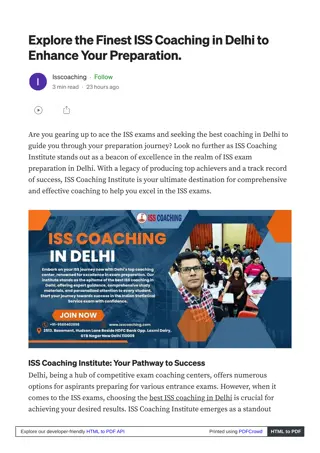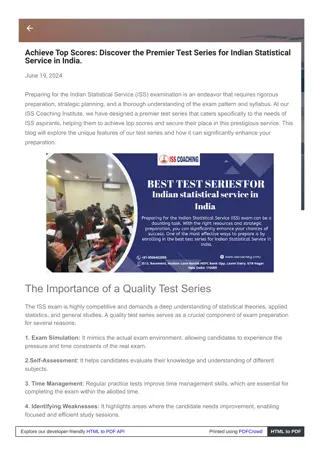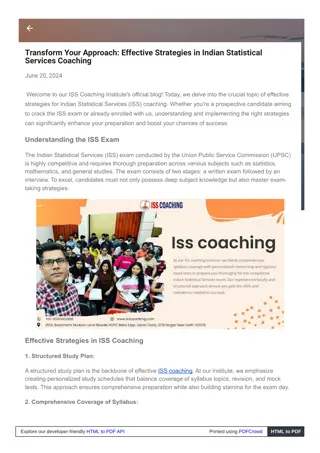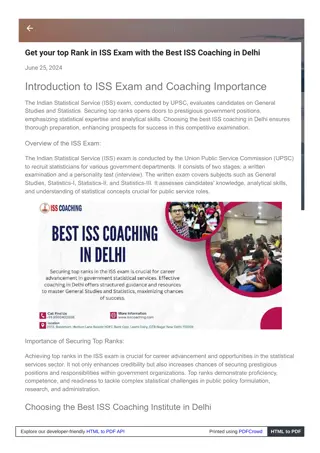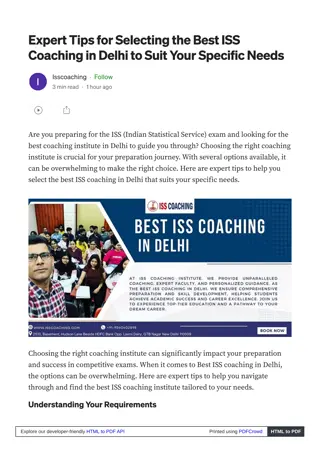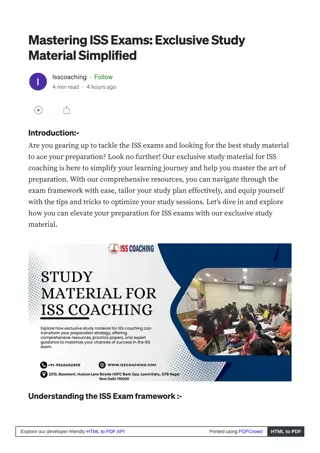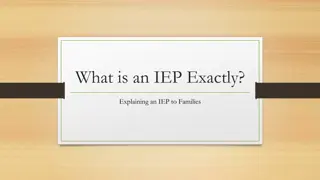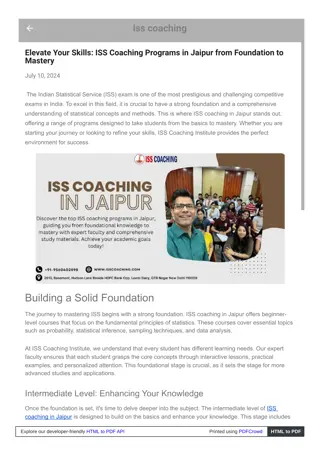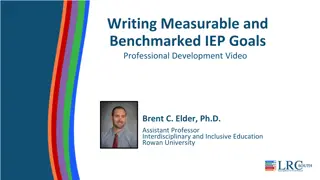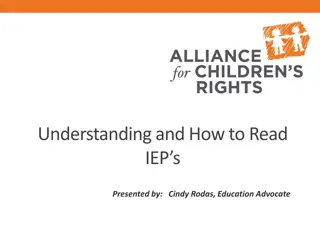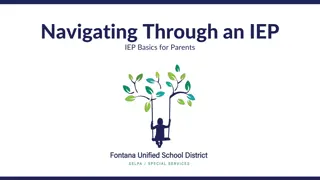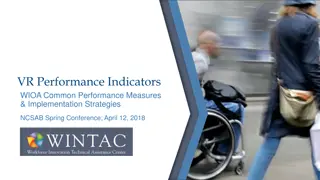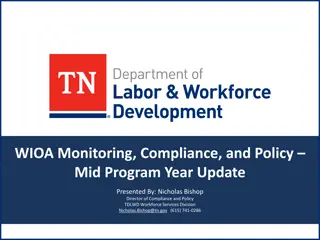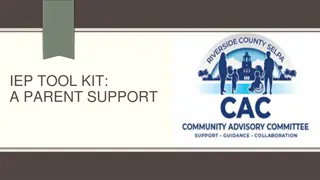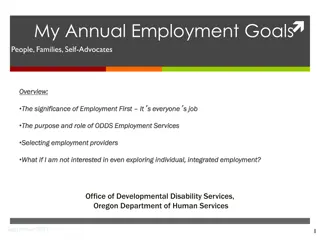Understanding Individual Employment Plan (IEP) and Individual Service Strategy (ISS) in WIOA Training Academy
Individual Employment Plan (IEP) and Individual Service Strategy (ISS) are essential components of the WIOA Training Academy, tailored to meet the career needs of participants under various WIOA programs. IEPs focus on personalized career services for adults and dislocated workers, while ISSs are specific to youth programs. These plans aim to identify employment goals, achievement objectives, and the right mix of services to support participants. They ensure active involvement of participants in setting and updating their career goals, providing a roadmap for success. Jointly completed by participants and case managers, IEPs and ISSs are living documents that evolve with participants' progress and changing needs.
Download Presentation

Please find below an Image/Link to download the presentation.
The content on the website is provided AS IS for your information and personal use only. It may not be sold, licensed, or shared on other websites without obtaining consent from the author. Download presentation by click this link. If you encounter any issues during the download, it is possible that the publisher has removed the file from their server.
E N D
Presentation Transcript
Individual Employment Plan and Individual Service Strategy WIOA TRAINING ACADEMY 4thTraining Module March 17, 2022 10:00 a.m. 11:30 a.m. Originated by: Heather Pipkin (Eastern) Presented by: April Turner (NW) and Annette Hughey (SW)
Important Questions What is an IEP and ISS? Why are they necessary? How are they completed? Where do you find the information? When are they updated?
Individual Employment Plan (IEP) IEPs are individualized career services utilized for WIOA Title I Adult, WIOA Title I Dislocated Worker, and WIOA Title III Employment Service (Wagner-Peyser) programs. A plan developed by a participant and a case manager that identifies the appropriate employment goals, achievement objectives, and the appropriate combination of services for the participant to achieve the employment goals. This plan is an ongoing strategy to identify employment goals, achievement objectives, and the appropriate combination of services for the participant to achieve the employment goal. The plan may contain the chosen career pathway and steps to achieve the goals along the path [WIOA 134(c)(2)(A)(XII)(II); TEGL 19-16].
Individual Service Strategy (ISS) ISSs are youth services utilized by WIOA Title I Youth Programs only. The ISS identifies the participant's educational goals, employment goals including, when appropriate, non-traditional employment, suitable achievement objectives, barriers, needs assessment for supportive service and the appropriate mix of services.
Why are they necessary? Assure the participant s voice is represented and their needs are being met
Who is responsible for completing the IEP/ISS and how are they completed? The IEP and ISS are to be completed jointly with the participant and the case manager while using an array of information provided by the participant. They are living documents that must be modified each time there is a change within the plan/strategy.
Summarize Work Experience This is the participant s previous work history that should be found on their application. Remember, the IEP and ISS should always be completed with the participant. Ask the participant relevant questions. Compare what they say with the application to assure you are documenting everything correctly.
Summarize Educational Experiences and Achievements High School Diploma? (ISY - TABE test) College Work (Transcript) Certificate/Degree Written exams for CDL permit, drivers license ACT/SAT scores Work-keys Curriculum These are just a few examples.
Strengths and Interests Ask questions: What are you good at? What do you feel like you struggle with? What are your hobbies? www.mynextmove.org will have their strengths and interests listed
Potential Pathways What are the participant s employment goals? What type of work are they looking for? Remember: You don t want to place a truck driver at a desk, a clerical worker as a janitor, etc.
Long-term and Short-term Goals Long-term goal - Intended overall outcome (full-time employment as a nurse); (complete nursing program) Short-term goal(s) - Small achievements toward the long-term goal(s) Measurable Skills Gains goals Register for classes Participate in Work Experience Successfully complete Work Experience/OST
Barriers and Overcoming Them Located in application, assessments, and when speaking with participants Homeless or Runaway Childcare Low-income High School Dropout Offender/Ex-Offender BSD/ELL Transportation Pregnant or Parenting Lacks skills or training Foster care or aging out Public Assistance Disability Little to no work history Other
Services Needed for Participation Eligibility Determination Adult, DLW, and Youth Initial Assessment Adult and DLW Objective Assessment - Youth IEP Adult and DLW ISS - Youth
Career Services Available (IEP) Workforce Information Services Comprehensive and Specialized Assessments Out of Area Job Search Assistance ELL and Integrated Training Programs Assessment of Skills Level Group or Individualized Counseling and Mentoring Career Planning Labor Exchange Services & LMI Referrals and Co-Enrollment Short-term Pre-Vocational Services Work-Based Learning Performance Information Supportive Service Information Financial Literacy Training Services Follow-up Services Supportive Services
Memorandum of Understanding (MOU) 14 Program Elements (Youth) MOUs are encouraged to be developed with partners and/or other entities to assist with providing the 14 Program Elements. Please refer to your MOU chart when completing this section on the ISS.
14 Youth Program Elements (ISS) Answer each of these questions for each element: Why is the element needed? Who will provide the element and how? Will youth be referred? If yes to what entity or program? Will the youth be co-enrolled?
Supportive Services Available Based on everything that has been gathered, what supportive services are needed for the participant to achieve their long-term goals? Linkages to community services Transportation Assistance Assistance with childcare or dependent care Assistance with housing Needs related payments Assistance with educational testing fees Reasonable accommodations for individuals with disabilities Legal Aid services Referral to Health care Utility Assistance Assistance with uniforms, work attire or work-related tools Books, school supplies, laptops, etc. Payments and fees for employment and training related applications, tests, and certifications Other (please explain)
Referrals and Co-Enrollment Based upon all information gathered, where should the participant be referred? Adult (WIOA) Arkansas Rehabilitation Services Out of School Youth (WIOA) Division of Services for the Blind Dislocated Worker (WIOA) Arkansas Human Development Corp TANF Department of Workforce Services Adult Education and Literacy Housing/Utility Assistance Programs Legal Aid Career Pathways TAA Other Non-WIOA Partners (please explain)
Using a Case Note for Updates or Modifications When the plan changes, change the ISS/IEP. This could be on the modification form; case note or email from the participant which could be attached to the ISS/IEP that has: The change The date The signature of the Case Manager The signature of the participant OR something in writing by the Case Manager as to how the change was discussed and agreed to by the participant Enter another IEP/ISS as a transactional service to acknowledge the change to the plan
Reminders The IEP and ISS should always be completed with the participant. Speak with your participant; compare what they say to the documentation received to assure you are documenting everything correctly and nothing is being left out. The IEP and ISS are living documents which must be modified each time there is a change.
Please listen carefully: The $25 dollar answer today will pertain to the information presented in the skit by Heather Pipkin and Liz Smith.
Thanks to Northwest Arkansas Economic Development District for providing the $25 electronic gift card.

 undefined
undefined


